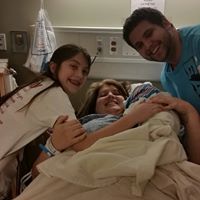Matthew D Fischer
age ~46
from Long Beach, CA
- Also known as:
-
- Matt D Fischer
- Matthew Fisher
- Matthew Ficher
- Phone and address:
-
2619 Ladoga Ave, Long Beach, CA 90815
5622431917
Matthew Fischer Phones & Addresses
- 2619 Ladoga Ave, Long Beach, CA 90815 • 5622431917
- Garden Grove, CA
- Lakewood, CA
- Santa Clara, CA
- Los Angeles, CA
- 12351 Casper St, Garden Grove, CA 92845 • 7148785663
Education
-
Degree:Associate degree or higher
Medicine Doctors

Matthew J. Fischer
view sourceSpecialties:
Internal Medicine
Work:
Chesapeake Bay Internal Medicine
2 Martin Ct STE 1, Easton, MD 21601
4108200621 (phone), 4108200643 (fax)
2 Martin Ct STE 1, Easton, MD 21601
4108200621 (phone), 4108200643 (fax)
Education:
Medical School
George Washington University School of Medicine and Health Science
Graduated: 1994
George Washington University School of Medicine and Health Science
Graduated: 1994
Procedures:
Allergen Immunotherapy
Electrocardiogram (EKG or ECG)
Skin Tags Removal
Vaccine Administration
Electrocardiogram (EKG or ECG)
Skin Tags Removal
Vaccine Administration
Conditions:
Acne
Constipation
Contact Dermatitis
Diabetes Mellitus (DM)
Disorders of Lipoid Metabolism
Constipation
Contact Dermatitis
Diabetes Mellitus (DM)
Disorders of Lipoid Metabolism
Languages:
English
Description:
Dr. Fischer graduated from the George Washington University School of Medicine and Health Science in 1994. He works in Easton, MD and specializes in Internal Medicine.

Matthew J. Fischer
view sourceSpecialties:
Internal Medicine
Work:
Old Orchard Medical GroupOrchard Medical Group
4905 Old Orch Ctr Lowr Ll, Skokie, IL 60077
8476796707 (phone), 8476796721 (fax)
4905 Old Orch Ctr Lowr Ll, Skokie, IL 60077
8476796707 (phone), 8476796721 (fax)
Education:
Medical School
University of Illinois, Chicago College of Medicine
Graduated: 1995
University of Illinois, Chicago College of Medicine
Graduated: 1995
Procedures:
Electrocardiogram (EKG or ECG)
Pulmonary Function Tests
Vaccine Administration
Pulmonary Function Tests
Vaccine Administration
Conditions:
Acute Bronchitis
Acute Conjunctivitis
Acute Pharyngitis
Acute Sinusitis
Alopecia Areata
Acute Conjunctivitis
Acute Pharyngitis
Acute Sinusitis
Alopecia Areata
Languages:
English
Spanish
Spanish
Description:
Dr. Fischer graduated from the University of Illinois, Chicago College of Medicine in 1995. He works in Skokie, IL and specializes in Internal Medicine. Dr. Fischer is affiliated with Glenbrook Hospital and Northshore University Health System Evanston Hospital.

Matthew P. Fischer
view sourceSpecialties:
Family Medicine
Work:
Aurora Health Center
855 N Westhaven Dr, Oshkosh, WI 54904
9203038700 (phone), 9203034128 (fax)
855 N Westhaven Dr, Oshkosh, WI 54904
9203038700 (phone), 9203034128 (fax)
Education:
Medical School
University of Iowa Carver College of Medicine
Graduated: 1983
University of Iowa Carver College of Medicine
Graduated: 1983
Procedures:
Arthrocentesis
Circumcision
Destruction of Benign/Premalignant Skin Lesions
Electrocardiogram (EKG or ECG)
Hearing Evaluation
Skin Tags Removal
Vaccine Administration
Circumcision
Destruction of Benign/Premalignant Skin Lesions
Electrocardiogram (EKG or ECG)
Hearing Evaluation
Skin Tags Removal
Vaccine Administration
Conditions:
Abnormal Vaginal Bleeding
Acute Bronchitis
Acute Conjunctivitis
Acute Pharyngitis
Acute Sinusitis
Acute Bronchitis
Acute Conjunctivitis
Acute Pharyngitis
Acute Sinusitis
Languages:
English
Spanish
Spanish
Description:
Dr. Fischer graduated from the University of Iowa Carver College of Medicine in 1983. He works in Oshkosh, WI and specializes in Family Medicine. Dr. Fischer is affiliated with Aurora Medical Center -Oshkosh, Aurora St Lukes Medical Center and Froedtert Lutheran Memorial Hospital.

Matthew Adam Fischer
view sourceUs Patents
-
Immediate Negative Acknowledgement For A Communication Network
view source -
US Patent:6640325, Oct 28, 2003
-
Filed:May 22, 2000
-
Appl. No.:09/577677
-
Inventors:Matthew J. Fischer - Mountain View CA
-
Assignee:Advanced Micro Devices, Inc. - Sunnyvale CA
-
International Classification:G08C 2502
-
US Classification:714748, 709232
-
Abstract:A method and system for providing a low-level recovery of data on a communication network that provides an immediate negative acknowledgement of a data packet that contains bit errors, as determined by a receiving node on the network. The data packets contain two error detection mechanisms, with the first error detection mechanism being used by the receiving node to determine whether the data packet is uniquely addressed to that receiving node. When this is determined by the receiving node, the data payload is then checked to determine whether it contains a bit error. When an error is detected, the receiving node immediately sends out a negative acknowledgement, prior to the normal interframe spacing provided in network protocols, so that the transmitting node becomes aware that the data packet was not properly received at the receiving node. The transmitting node can then retransmit the data packet.
-
Pci And Mii Compatible Home Phoneline Networking Alliance (Hpna) Interface Device
view source -
US Patent:6701406, Mar 2, 2004
-
Filed:Feb 2, 2001
-
Appl. No.:09/776339
-
Inventors:Chi-Sheng Chang - San Jose CA
Chin-Wei Liang - Sunnyvale CA
Matthew J. Fischer - Mountain View CA -
Assignee:Advanced Micro Devices, Inc. - Sunnyvale CA
-
International Classification:G06F 1300
-
US Classification:710310, 710315
-
Abstract:A networking interface device for coupling a system host having one of a plurality configurations to a network medium. The networking interface device has a peripheral component interconnect (PCI) interface for coupling the interface device to a system host configured with a PCI based system bus interface; a medium independent interface (MII) for coupling the interface device to a system host configured with a media access controller (MAC) based system bus interface; and a buffer management device (BMU) having an active state for bursting data packet traffic via the PCI interface when the interface device is coupled to a PCI based system bus interface and a passive state for continuously passing data packet traffic via the MII when the interface device is coupled to a MAC based system bus interface.
-
Synchronized Transport Across Non-Synchronous Networks
view source -
US Patent:6747996, Jun 8, 2004
-
Filed:Dec 7, 2000
-
Appl. No.:09/732213
-
Inventors:John T. Holloway - Atherton CA
Matthew James Fischer - Mountain View CA
Jason Alexander Trachewsky - Palo Alto CA -
Assignee:Broadcom Corporation - Irvine CA
-
International Classification:H04J 306
-
US Classification:370503, 370516
-
Abstract:A method of providing for synchronizing one or more synchronous terminals with one or more synchronous endpoints, each synchronous terminal and each synchronous endpoint having an asynchronous communications network coupled between at least one synchronous terminal and at least one synchronous endpoint. A synchronization protocol is established between a synchronous terminal and a synchronous end point by providing a gateway between the asynchronous communications network and the synchronous end point, the gateway communicating with the synchronous terminal over the asynchronous communications network in accordance with the synchronization protocol. The synchronization protocol includes sending a message from the gateway to the synchronous terminal, the message containing a timestamp identifying a clock associated with the synchronous end point. The synchronous terminal establishes a clock associated with the synchronous terminal by creating a clock estimate based upon the timestamp message and access jitter expected from the asynchronous communications network such that the clock associated with the synchronous terminal enables packet sampling and transmission onto the asynchronous communications network to and from the synchronous terminal to be synchronized with the clock associated with the synchronous end point.
-
Method For Reducing Collisions, Latency And Latency Jitter In A Network By Maintaining A Contention-Resolution Derived Queue Ordering
view source -
US Patent:6807189, Oct 19, 2004
-
Filed:Apr 7, 2000
-
Appl. No.:09/545514
-
Inventors:Matthew J. Fischer - Mountain View CA
-
Assignee:Advanced Micro Devices, Inc. - Sunnyvale CA
-
International Classification:H04L 108
-
US Classification:370447
-
Abstract:A network interface examines a field of a successfully transmitted frame following a contention resolution and transmission ordering among a plurality of nodes contending for transmission of a frame. The field indicates whether the successfully transmitting node has any additional frames to transmit. The number of backoff slots is maintained at a current value, rather than decremented, if the field indicates that the successfully transmitting node has an additional frame to transmit. The next frame to be transmitted is assigned the highest backoff slot. This procedure avoids re-contention and re-ordering when the contending nodes have additional frames to transmit, thereby improving overall network performance.
-
Method For Distributing Sets Of Collision Resolution Parameters In A Frame-Based Communications Network
view source -
US Patent:6877043, Apr 5, 2005
-
Filed:Apr 4, 2001
-
Appl. No.:09/825689
-
Inventors:Tracy D. Mallory - Palo Alto CA, US
Matthew James Fischer - Mountain View CA, US -
Assignee:Broadcom Corporation - Irvine CA
-
International Classification:G06F015/16
-
US Classification:709251, 709252, 709253
-
Abstract:A method for distributing sets of collision resolution parameters to be used for resolution of network access contention events among nodes of a non-centralized media access control shared medium network. A set of collision resolution parameters is provided which includes a sequence of fixed numbers for resolving a single network access contention event. A single collision signal slot master node is identified when one or more candidate collision signal slot master nodes exist. Collision signal slot request messages are sent from client nodes addressed to all network nodes. Collision signal slot assignment messages are sent from the master node to the client nodes. A collision resolution parameter set to be employed by that given client node is obtained at a given client node from within a received collision signal slot assignment message. Collision signal slot acknowledgment messages are sent from client nodes addressed to all network nodes. Collision signal slot drop messages are sent from client nodes addressed to all network nodes.
-
Method Of Controlling Data Sampling Clocking Of Asynchronous Network Nodes In A Frame-Based Communications Network
view source -
US Patent:6975655, Dec 13, 2005
-
Filed:Apr 4, 2001
-
Appl. No.:09/826067
-
Inventors:Matthew James Fischer - Mountain View CA, US
Tracy D. Mallory - Palo Alto CA, US -
Assignee:Broadcom Corporation - Irvine CA
-
International Classification:H04L012/28
H04J003/06 -
US Classification:370516, 37039562, 375356
-
Abstract:A method of controlling data sampling clocking of asynchronous network nodes, each asynchronous network node having a local clock and transmitting and receiving packets to and from an asynchronous network according to an asynchronous network media access protocol. An asynchronous network node capable of transmitting and receiving packets on the asynchronous network is designated as a master node. Each non-master asynchronous network node which desires to synchronously transport packets across the asynchronous network is designated as a slave node. A master node clock of the master node is synchronized with a slave node clock of each slave node. Each slave node clock is continuously corrected compared with the master node clock to smooth slave clock error to an average of zero compared with the master clock as a reference using timestamp information from the master node. A derivative clock at the slave node is derived from the continuously correcting each slave node clock to control data sampling at the slave node.
-
Network Interface Apparatus And Method Of Internal Communication Within The Same
view source -
US Patent:6978318, Dec 20, 2005
-
Filed:Jun 19, 2000
-
Appl. No.:09/597371
-
Inventors:Philip J. Keller - Fremont CA, US
Yatin R. Acharya - Sunnyvale CA, US
Matthew J. Fischer - Mountain View CA, US -
Assignee:Advanced Micro Devices, Inc. - Sunnyvale CA
-
International Classification:G06F015/16
-
US Classification:709250, 709227, 709236, 709253
-
Abstract:A network interface includes a network medium interface operatively coupled to a software device driver arrangement, with a legacy media access controller (MAC) therebetween. The device driver arrangement includes a legacy MAC device driver configured to communicate with the legacy MAC, and an intermediate driver configured to communicate with the network medium interface. The intermediate driver and the network medium interface may communicate with one another by use of special frames, for example to send and receive control information. The special frames are formatted to pass through the legacy MAC, and include an identifier so that they can be identified at the intended destination, either the intermediate driver or the network medium interface. Upon identification, the control information is extracted at the destination. The network medium interface may include one or more MACs as well as one or more physical layer devices (PHYs).
-
Method Of Providing Synchronous Transport Of Packets Between Asynchronous Network Nodes In A Frame-Based Communications Network
view source -
US Patent:7000031, Feb 14, 2006
-
Filed:Apr 4, 2001
-
Appl. No.:09/825851
-
Inventors:Matthew James Fischer - Mountain View CA, US
Tracy D. Mallory - Palo Alto CA, US -
Assignee:Broadcom Corporation - Irvine CA
-
International Classification:G06F 15/16
H04J 3/06 -
US Classification:709248, 709209, 370503, 370509
-
Abstract:A method of providing synchronous transport of packets between asynchronous network nodes. An asynchronous network node capable of transmitting and receiving packetson the asynchronous network is designated as a master node. Each non-master asynchronous network node which desires to synchronously transport packets across the asynchronous network is designated as a slave node. Best arrival times for packets transmitted from slave nodes to the master node are communicated from the master node to the slave nodes. Bestpacket assembly times for packets to be transmitted by the particular slave node to the master node in the future for the packets to be received by the master node at future master clock referenced best arrival times are determined. Packets for transmission at slave nodes are prepared and transmitted according to determined future bestpacket assembly time information.
Name / Title
Company / Classification
Phones & Addresses
Attorney
TAUBMAN, SIMPSON, YOUNG & SULENTOR, A PROFESSIONAL CORPORATION
Attorneys Office
Attorneys Office
1 World Trade Ctr STE 400, Long Beach, CA 90831
5624369201, 5625909695
5624369201, 5625909695
MEW-HY PROPERTIES, LLC
BARONE BROTHERS 2000, LLC
SPIRITS & LIQUOR LTD, LLC
SCHWEICKERT PROPERTIES, LLC
MEWHORT PROPERTIES, LLC
A & S COMMERCIAL CONTRACTORS, LLC
MVLC 37, LLC
Resumes

Attorney
view sourceLocation:
225 Broadway, New York, NY 10007
Industry:
Law Practice
Work:
Taubman, Simpson, Young & Sulentor since Sep 2005
Associate
Associate
Education:
Loyola Law School, Loyola Marymount University
Skills:
Litigation
Legal Research
Civil Litigation
Trials
Legal Writing
Legal Assistance
Mediation
Courts
Personal Injury
Family Law
Criminal Defense
Estate Planning
Commercial Litigation
Legal Research
Civil Litigation
Trials
Legal Writing
Legal Assistance
Mediation
Courts
Personal Injury
Family Law
Criminal Defense
Estate Planning
Commercial Litigation

Matthew Fischer
view source
Matthew Fischer
view source
Matthew Fischer
view source
Matthew Fischer
view sourceLocation:
United States

Matthew Fischer
view sourceLocation:
United States

Matthew Fischer
view sourceLocation:
United States

Writing And Editing Professional
view sourceLocation:
Greater Los Angeles Area
Industry:
Writing and Editing
Education:
Indiana State University
License Records
Matthew Russell Fischer
License #:
PTC.022994 - Active
Issued Date:
Jul 15, 2015
Expiration Date:
Jan 15, 2017
Type:
Pharmacy Technician Candidate
Lawyers & Attorneys

Matthew David Fischer, Long Beach CA - Lawyer
view sourceAddress:
Taubman, Simpson, Young & Sulentor, A Professional Corporation
One World Trade Center Suite 400, Long Beach, CA 90831
One World Trade Center Suite 400, Long Beach, CA 90831
Licenses:
California - Active 2005
Education:
Loyola Law School, Loyola Marymount University
Degree - JD - Juris Doctor - Law
Graduated - 2005
Santa Clara University
Degree - BS - Bachelor of Science - Political Science
Graduated - 2001
Santa Clara University
Degree - BA - Bachelor of Arts - Communication
Graduated - 2001
Degree - JD - Juris Doctor - Law
Graduated - 2005
Santa Clara University
Degree - BS - Bachelor of Science - Political Science
Graduated - 2001
Santa Clara University
Degree - BA - Bachelor of Arts - Communication
Graduated - 2001
Specialties:
General Practice - 100%

Matthew Fischer - Lawyer
view sourceOffice:
Marshall & Melhorn, LLC
Specialties:
Real Estate
Commercial Transactions
Real Property Law
Commercial Transactions
Real Property Law
ISLN:
900879942
Admitted:
1991
University:
University of Toledo, B.B.A., 1984; University of Toledo, B.B.A., 1984
Law School:
University of Toledo, J.D., 1990; University of Toledo, J.D., 1990

Matthew Fischer - Lawyer
view sourceOffice:
Sedgwick LLP
Specialties:
Antitrust
Commercial Litigation
Intellectual Property
Intellectual Property Law
Commercial Litigation
Intellectual Property
Intellectual Property Law
ISLN:
912413592
Admitted:
1997
University:
Kenyon College, B.A., 1991
Law School:
University of California, Boalt Hall School of Law, J.D., 1997

Matthew D. Fischer, Long Beach CA - Lawyer
view sourceOffice:
Taubman, Simpson, Young & Sulentor A Professional Corporation
One World Trade Center, Suite 400, Long Beach, CA 90831
One World Trade Center, Suite 400, Long Beach, CA 90831
Phone:
5624369201 (Phone), 5625909695 (Fax)
Specialties:
Construction Law
Oil and Gas Law
Litigation
Real Estate
Business Law
Oil and Gas Law
Litigation
Real Estate
Business Law
Memberships:
Long Beach Bar Association
State Bar of California.
State Bar of California.
ISLN:
918628921
Admitted:
2005, California and U.S. District Court, Central District of California
University:
Santa Clara University, B.S., 2001
Law School:
Loyola Law School of Los Angeles, J.D., 2005
Links:
Site
Biography:
Matthew D. Fischer received his Bachelor of Science in Political Science and Bachelor of Arts in Communication degrees from Santa Clara University in 2001, where he also was a member of the intercolle...

Matthew Augustus Fischer - Lawyer
view sourceAddress:
One Market Plaza
Phone:
4157817900 (Phone), 4157812635 (Fax)
Work:
Sedgwick Detert Moran & Arnold LLP
Experience:
28 years
Specialties:
Antitrust
Business Law
Intellectual Property
Antitrust & Trade Practices
Business Litigation
Commercial Practices
Business Law
Intellectual Property
Antitrust & Trade Practices
Business Litigation
Commercial Practices
Jurisdiction:
California (1997)
California
9th U.S. Circuit Court of Appeals
U.S. District Court (E.D. Cal.)
U.S. District Court (N.D. Cal.)
U.S. District Court (S.D. Cal.)
California
9th U.S. Circuit Court of Appeals
U.S. District Court (E.D. Cal.)
U.S. District Court (N.D. Cal.)
U.S. District Court (S.D. Cal.)
Law School:
University of California
Education:
University of California, JD
Kenyon College, BA
Kenyon College, BA
Memberships:
California State Bar (1997)
Googleplus

Matthew Fischer
Lived:
Cheshire, CT
Los Angeles, CA
San Francisco, CA
Pullman, WA
Carlsbad, CA
Orange, CT
Westville, CT
Los Angeles, CA
San Francisco, CA
Pullman, WA
Carlsbad, CA
Orange, CT
Westville, CT
Work:
CAS-CIAC - Director of Information Services
San Francisco State University
San Francisco Giants
Chapman College
Wirz & Associates
E-fish Solutions, inc.
CAS-CIAC
San Francisco State University
San Francisco Giants
Chapman College
Wirz & Associates
E-fish Solutions, inc.
CAS-CIAC
Education:
University High School - Los Angeles, CA, San Francisco State University, Washington State University

Matthew Fischer
Lived:
Cheshire, CT
Carlsbad, CA
Foster City, CA
New Haven, CT
Orange, CT
Orange, CA
Los Angeles, CA
Carlsbad, CA
Foster City, CA
New Haven, CT
Orange, CT
Orange, CA
Los Angeles, CA
Work:
CAS-CIAC - Director of Information Services (2001)
E-fish solutions, inc. - President (2000-2007)
Fishman Communications - Owner (1995-2000)
Wirz & Associates - Vice President (1994-1995)
Upper Deck Company - PR Manager - Heroes of Baseball (1993-1994)
San Francisco Giants - Media Relations Director (1989-1993)
Chapman College - Assistant Athletic Director/SID (1985-1989)
E-fish solutions, inc. - President (2000-2007)
Fishman Communications - Owner (1995-2000)
Wirz & Associates - Vice President (1994-1995)
Upper Deck Company - PR Manager - Heroes of Baseball (1993-1994)
San Francisco Giants - Media Relations Director (1989-1993)
Chapman College - Assistant Athletic Director/SID (1985-1989)
Education:
Washington State University - Communications, San Francisco State University - Journalism
Relationship:
Married

Matthew Fischer
Work:
Trans-Pecos Well Logging - Mudlogger (2012)
Patriot Mudlogging - Mudlogger (10-2012)
Patriot Mudlogging - Mudlogger (10-2012)
Education:
Rocksprings High School

Matthew Fischer
Work:
Realestateinnovations.com (2008)

Matthew Fischer
Education:
Germantown Elementary

Matthew Fischer
Tagline:
I'm a good loyal friend, a storm chaser, a drinker of captain morgan and i love my family, oh a White Sox fan and Blackhawks Fan
Bragging Rights:
Nothing to brag

Matthew Fischer

Matthew Fischer
Flickr
Youtube
Myspace
Plaxo

Matthew Fischer
view sourceBiltmore LakeSonopress LLC Past: AOL, TV Guide Online, iGuide, NetGuide

Matthew Fischer
view source
Matthew Fischer
view sourceCheshire, CTDirector of Information Services at Connecticut As...

Matthew Fischer
view sourceone wellness

Maciej Matthew Fischer
view source
Matthew Fischer
view source
Matthew Raymond Fischer
view source
Matthew F Fischer
view source
Matthew John Fischer
view source
Matthew W Fischer
view source
Matthew Fischer
view source
Matthew Fischer
view sourceClassmates

Matthew Fischer
view sourceSchools:
Central High School Alexandria MN 1972-1973, Central Junior High School Alexandria MN 1972-1973
Community:
David Phifer

Matthew Fischer
view sourceSchools:
Eisenhower High School Saginaw MI 1982-1986
Community:
Brian Moss

Matthew Fischer
view sourceSchools:
Overlea High School Baltimore MD 2002-2006
Community:
Quinn Rossi

Matthew Fischer
view sourceSchools:
Kettle Moraine Lutheran High School Jackson WI 1987-1991
Community:
Chris Cole, Linda Buck

Matthew Fischer
view sourceSchools:
St. Andrews College Aurora Morocco 1993-1997
Community:
Greg Hamlen, David Black, John Livingston

Matthew Fischer
view sourceSchools:
Manistee Catholic High School Manistee MI 1986-1990
Community:
Jeff Jankowski, Carol Abramczyk, Patrick Purgiel, Valerie Abramczyk, Denise Cole

Matthew Fischer
view sourceSchools:
Wright Elementary School San Antonio TX 1971-1973, Parr Elementary School Arvada CO 1973-1976, East Arvada Junior High School Arvada CO 1976-1978
Community:
Mona Madsen

Matthew Fischer
view sourceSchools:
American School of Paris Paris CA 1985-1989
Community:
Benjamin Horowitz, Wallace Driver, Winthrop Morgan, Rebecca Bateman, Rod Bishop
Get Report for Matthew D Fischer from Long Beach, CA, age ~46















